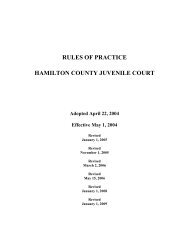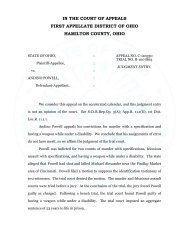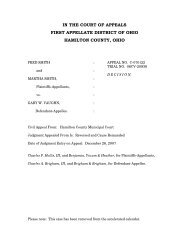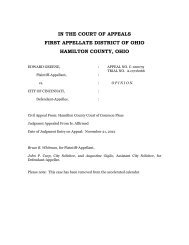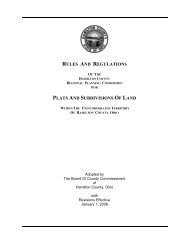State v. Clark - Hamilton County, Ohio
State v. Clark - Hamilton County, Ohio
State v. Clark - Hamilton County, Ohio
You also want an ePaper? Increase the reach of your titles
YUMPU automatically turns print PDFs into web optimized ePapers that Google loves.
IN THE COURT OF APPEALS<br />
FIRST APPELLATE DISTRICT OF OHIO<br />
HAMILTON COUNTY, OHIO<br />
STATE OF OHIO,<br />
Plaintiff-Appellee,<br />
vs.<br />
JASHAWN CLARK,<br />
Defendant-Appellant.<br />
:<br />
:<br />
:<br />
:<br />
:<br />
APPEAL NO. C-110137<br />
TRIAL NO. B-0903962-B<br />
JUDGMENT ENTRY.<br />
We consider this appeal on the accelerated calendar, and this judgment entry is<br />
not an opinion of the court. See S.Ct.R.Rep.Op. 2; App.R. 11.1(E); 1st Dist.Loc.R. 11.1.1.<br />
Following a jury trial, defendant-appellant Jashawn <strong>Clark</strong> was convicted of<br />
three counts of felonious assault under R.C. 2903.11(A)(2), one count of improper<br />
discharge of a firearm into a habitation under R.C. 2923.161(A), two counts of having<br />
weapons while under a disability under R.C. 2923.13(A)(3), and two counts of<br />
aggravated murder under R.C. 2903.01(A).<br />
Several of these counts had<br />
accompanying firearm specifications. These convictions resulted from two separate<br />
shootings that occurred over a three-week period in March 2009.<br />
The trial court sentenced <strong>Clark</strong> to two consecutive terms of life imprisonment<br />
without parole for the two aggravated murder convictions, which included a five-year<br />
prison sentence on a firearm specification. The court also sentenced him to an<br />
aggregate prison term of 11 years on the remaining counts and specifications.<br />
<strong>Clark</strong> has a filed a timely appeal from these convictions. He was tried with<br />
two co-defendants, Eric Long and Fonta Whipple, whose convictions we affirmed in
OHIO FIRST DISTRICT COURT OF APPEALS<br />
<strong>State</strong> v. Long, 1st Dist. No. C-110160, 2012-<strong>Ohio</strong>-3052, and <strong>State</strong> v. Whipple, 1st<br />
Dist. No. C-110184, 2012-<strong>Ohio</strong>-2938.<br />
<strong>Clark</strong> raises seven assignments of error for review. In his first assignment of<br />
error, he contends that the trial court erred by overruling his motion to sever the<br />
counts related to the two separate shootings for trial.<br />
He argues that he was<br />
prejudiced because the court permitted those counts to be tried together.<br />
Our review of the record shows that <strong>Clark</strong> was not prejudiced by the court’s<br />
failure to sever the counts related to each shooting because the evidence related to<br />
each shooting was simple and direct and the jury could easily segregate the proof for<br />
each offense. Therefore, the trial court did not abuse its discretion in overruling<br />
<strong>Clark</strong>’s motion to sever. See <strong>State</strong> v. Coley, 93 <strong>Ohio</strong> St.3d 253, 259-261, 754 N.E.2d<br />
1129 (2001); Long at 11-20; Whipple at 13-18. We overrule <strong>Clark</strong>’s first<br />
assignment of error.<br />
In his second assignment of error, <strong>Clark</strong> contends that the evidence was not<br />
sufficient to support his convictions. In his fourth assignment of error, he contends<br />
that the trial court erred in overruling his Crim.R. 29 motions for judgments of<br />
acquittal on all counts, which is a same as a claim that the evidence was insufficient<br />
to support the convictions. See <strong>State</strong> v. Jones, 1st Dist. No. C-080518, 2009-<strong>Ohio</strong>-<br />
4190, 41.<br />
Our review of the record shows that a rational trier of fact, after viewing the<br />
evidence in a light most favorable to the prosecution, could have found that the state<br />
had proved beyond a reasonable doubt all the elements of felonious assault, having<br />
weapons while under a disability, improper discharge of a firearm into a habitation<br />
and aggravated murder.<br />
Therefore, the evidence was sufficient to support the<br />
convictions, and we overrule <strong>Clark</strong>’s second and fourth assignments of error. See<br />
2
OHIO FIRST DISTRICT COURT OF APPEALS<br />
<strong>State</strong> v. Jenks, 61 <strong>Ohio</strong> St.3d 259, 574 N.E.2d 492 (1991), paragraph two of the<br />
syllabus; Long, 2012-<strong>Ohio</strong>-3052, at 48-49; Whipple, 2012-<strong>Ohio</strong>-2938, at 20-24.<br />
In his third assignment of error, <strong>Clark</strong> contends that his convictions were<br />
against the manifest weight of the evidence. After reviewing the record, we cannot<br />
say that the jury lost its way and created such a manifest miscarriage of justice that<br />
we must reverse <strong>Clark</strong>’s convictions and order a new trial. Therefore, the convictions<br />
are not against the manifest weight of the evidence. See <strong>State</strong> v. Thompkins, 78 <strong>Ohio</strong><br />
St.3d 380, 387, 678 N.E.2d 541 (1997); Long at 41-47; Whipple at 20-24. We<br />
overrule <strong>Clark</strong>’s third assignment of error.<br />
In his fifth assignment of error, <strong>Clark</strong> contends that the trial court erred in<br />
imposing excessive sentences. Our review of the record shows that the sentences<br />
were not contrary to law, or so arbitrary, unreasonable or unconscionable as to<br />
connote an abuse of discretion. Therefore, the trial court did not err in imposing<br />
them, and we overrule <strong>Clark</strong>’s fifth assignment of error. See <strong>State</strong> v. Kalish, 120<br />
<strong>Ohio</strong> St.3d 23, 2008-<strong>Ohio</strong>-4192, 896 N.E.2d 124, 26; <strong>State</strong> v. <strong>Clark</strong>, 71 <strong>Ohio</strong> St.3d<br />
466, 470, 644 N.E.2d 331 (1994); Long at 57-59.<br />
In his sixth assignment of error, <strong>Clark</strong> contends that the trial court erred in<br />
failing to instruct the jury on the lesser-included offense of involuntary manslaughter<br />
and the offense of inferior degree of voluntary manslaughter.<br />
We agree that<br />
involuntary manslaughter under R.C. 2903.04(A) is a lesser-included offense of<br />
aggravated murder under R.C. 2903.01(A) and that voluntary manslaughter under<br />
R.C. 2903.03(A) is an offense of inferior degree. See <strong>State</strong> v. Conway, 108 <strong>Ohio</strong><br />
St.3d 214, 2006-<strong>Ohio</strong>-791, 842 N.E.2d 996, 129 and 132.<br />
But the evidence, even when construed in <strong>Clark</strong>’s favor, was not sufficient to<br />
allow a jury to reasonably reject the greater offense and find him guilty of a lesser-<br />
3
OHIO FIRST DISTRICT COURT OF APPEALS<br />
included or inferior-degree offense. See Id. at 134. Nothing in the record supports<br />
the conclusion that <strong>Clark</strong> acted with any lesser level of intent than prior calculation<br />
and design or that he was under the influence of a sudden fit of passion or rage<br />
brought on by serious provocation by the victims. Therefore, the trial court did not<br />
err in failing to instruct the jury on involuntary manslaughter and voluntary<br />
manslaughter. See Id. at 129-137; <strong>State</strong> v. Thomas, 40 <strong>Ohio</strong> St.3d 213, 216-218,<br />
533 N.E.2d 286 (1988); 216-218; <strong>State</strong> v. Finley, 1st Dist. No. C-061052, 2010-<strong>Ohio</strong>-<br />
5203, 30-31; <strong>State</strong> v. Jackson, 1st Dist. No. C-090414, 2010-<strong>Ohio</strong>-4312, 9. We<br />
overrule <strong>Clark</strong>’s sixth assignment of error.<br />
Finally, in his seventh assignment of error, <strong>Clark</strong> contends that the trial court<br />
erred by allowing the state to present “other acts” evidence. Specifically, he argues<br />
that the trial court should not have allowed a witness testify that he had seen <strong>Clark</strong><br />
possess an assault rifle days before the first shooting. While evidence of other bad<br />
acts is generally inadmissible, Evid.R. 404(B) provides that it may be used to show<br />
motive, opportunity, intent preparation, plan, knowledge, identity or absence of<br />
mistake or accident. <strong>State</strong> v. Lukacs, 188 <strong>Ohio</strong> App.3d 597, 2010-<strong>Ohio</strong>-2364, 936<br />
N.E.2d 506, 37 (1st Dist.).<br />
In this case, the evidence was admissible to prove <strong>Clark</strong>’s identity as one of<br />
the shooters. Further, the evidence described the immediate background of the<br />
charged crimes and was inextricably related to those crimes. Consequently, the trial<br />
court did not abuse its discretion in admitting the testimony into evidence. See<br />
Long, 2012-<strong>Ohio</strong>-3052, at 32; Lukacs at 37-39; <strong>State</strong> v. Hirsch, 129 <strong>Ohio</strong> App.3d<br />
294, 308, 717 N.E.2d 789 (1st Dist.1998). We overrule <strong>Clark</strong>’s seventh assignment of<br />
error and affirm the trial court’s judgment.<br />
4
OHIO FIRST DISTRICT COURT OF APPEALS<br />
A certified copy of this judgment entry is the mandate, which shall be sent to the<br />
trial court under App.R. 27. Costs shall be taxed under App.R. 24.<br />
SUNDERMANN, P.J., HENDON and DINKELACKER, JJ.<br />
To the clerk:<br />
Enter upon the journal of the court on July 25, 2012<br />
per order of the court ____________________________.<br />
Presiding Judge<br />
5



